
Cleanroom Doors: Hidden Costs of Noise, Gaps & Seized Hinges
- By:Lisa
- 2025-09-16
- 29
In controlled environments, a cleanroom door serves a function far beyond simple ingress and egress. It acts as a critical barrier to uncontrolled airflow, a regulator of pressure differentials, a containment mechanism for particulate matter — and a key element in GMP compliance audits. Yet under budgetary constraints, many projects select “economical” cleanroom doors — low initial cost, rapid delivery, acceptable aesthetics. Within months, however, facility teams report persistent issues: incomplete sealing, hinge binding, operational noise, and repeated cleanliness alarms. The perceived savings? They return — often multiplied — in the form of product loss, audit remediation, and unplanned operational downtime.
This article examines the three critical failure modes of low-cost cleanroom doors — noise, leakage gaps, and seized hinges — through the lenses of engineering fundamentals, materials science, regulatory standards, and empirical performance data. We also provide actionable, engineering-grade mitigation strategies to support informed procurement and design decisions — whether specifying pharmaceutical cleanroom doors, airtight cleanroom doors, or evaluating the technical competence of cleanroom door suppliers.
1. Engineering Root Cause: A Contamination Incident Investigated
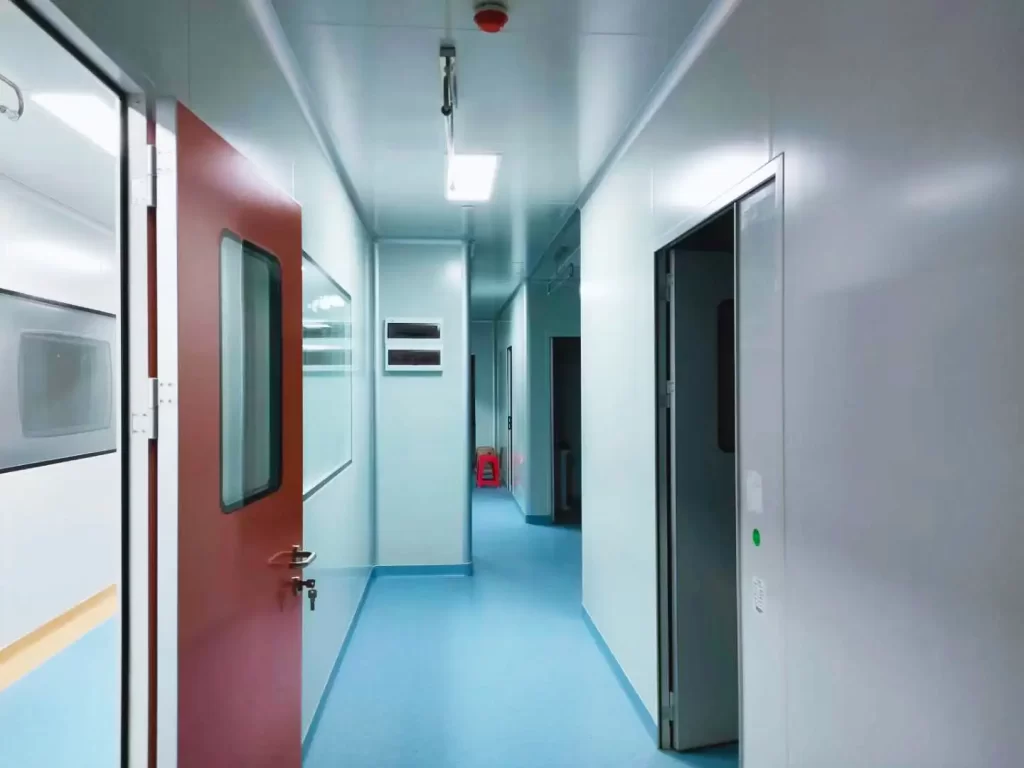
A biopharmaceutical manufacturing facility in Eastern China experienced a critical contamination event within its Grade C cleanroom: a high-value biologic batch failed pre-fill particulate testing and was subsequently quarantined. Root cause analysis traced the contamination source to the door separating the airlock from the main clean corridor — a persistent gap of approximately 1 mm at the header allowed unfiltered particulates to infiltrate under differential pressure.
Further investigation revealed the door was procured at roughly one-third the cost of industry-standard alternatives. It featured thin-gauge recycled aluminum framing, a single low-grade EPDM gasket, and chrome-plated carbon steel hinges. Within 12 months, thermal and humidity cycling induced frame warpage, the seal exhibited over 40% permanent compression set, and corrosion in the hinge mechanism prevented full closure.
This is not an isolated occurrence. Industry maintenance trend analyses indicate that over 15% of documented cleanroom contamination events are directly or indirectly attributable to door seal failure — the majority involving doors sourced from non-specialist manufacturers lacking validation to ISO 14644 airtightness requirements.
A cleanroom door is not merely a closure device — it is a dynamic airtight assembly. Its performance determines whether the controlled environment can sustain its specified pressure regime, particulate concentration, and microbial integrity. In biopharmaceutical applications, such doors must be regarded as pharmaceutical cleanroom doors — their failure constitutes a breach in the primary process containment barrier.
2. Failure Mode #1: Noise — An Indicator of Structural and Aerodynamic Instability
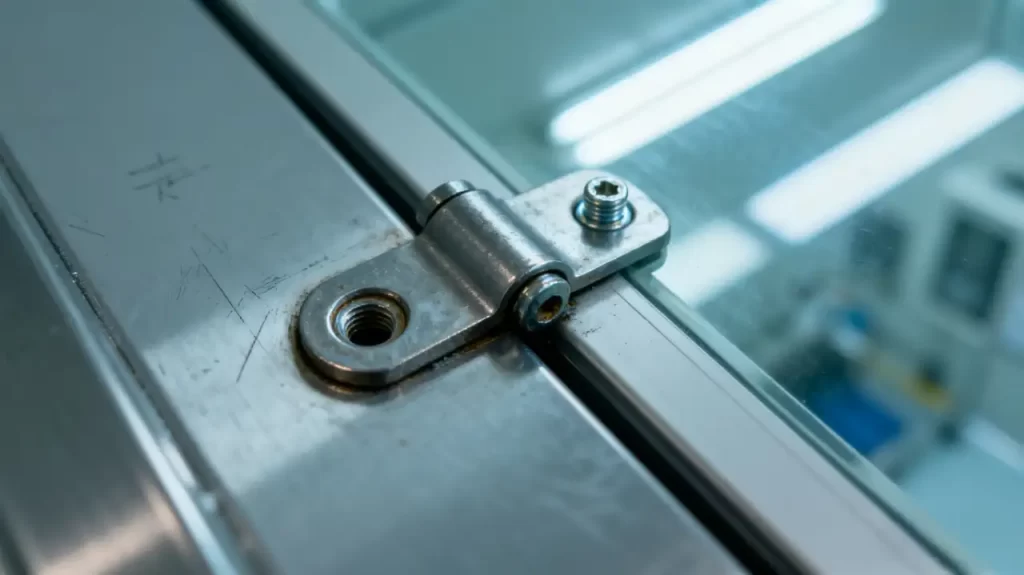
2.1 Manifestation: Beyond Audible Disturbance
Low-cost cleanroom doors frequently generate mechanical noise — rattling, vibration, or high-frequency screeching during operation. While often dismissed as a nuisance, in ISO Class 5 (Class 100) or higher environments, such disturbances can disrupt laminar airflow patterns, alter particle deposition trajectories, and induce localized cleanliness excursions.
2.2 Engineering Origins: Resonance and Tolerance Deviation
- Insufficient structural rigidity: To reduce material cost, some manufacturers utilize aluminum profiles below the industry-recommended minimum wall thickness (≥1.5 mm), without internal reinforcement. Door movement induces structural resonance, generating perceptible and measurable vibration.
- Poor hinge mounting tolerance: Economical doors commonly employ through-hole mounting with self-tapping screws, lacking embedded reinforcement plates. Over time, fastener holes elongate, hinge axes misalign, and lateral door oscillation amplifies — perturbing airflow uniformity.
- Incompatible door closer: Use of non-damped or low-precision closers results in uncontrolled impact forces, inducing secondary structural vibration.
2.3 Operational and Compliance Impact
- Laminar flow degradation: CFD simulations confirm that transient turbulence induced by door operation can elevate localized particle concentrations by multiple orders of magnitude under standard laminar conditions.
- Accelerated material degradation: Continuous vibration induces micro-displacement between seals and frames, hastening molecular chain scission in elastomeric materials. Empirical data indicates seal service life is reduced by more than 50% under vibratory conditions. Bearings similarly suffer from fatigue-induced failure.
- Instrument interference: In precision weighing or aseptic processing zones, mechanical noise can compromise the stability of high-sensitivity balances, introducing measurement deviations beyond acceptable process tolerances.
2.4 Regulatory Context: Noise as a Measurable Compliance Parameter
- ISO 14644-3:2019 stipulates maximum permissible background and transient noise levels in operational cleanrooms.
- GB 50073-2013 (Cleanroom Design Code) requires that equipment operation shall not generate vibration or acoustic emissions capable of interfering with critical processes.
Noise from low-cost doors is not an acoustic inconvenience — it is symptomatic of inadequate structural integrity and imprecise fabrication. Its implications extend beyond operator discomfort, directly threatening the core function of the cleanroom: preservation of stable airflow patterns and controlled pressure differentials. This applies equally to swing doors, sliding doors, and high-speed doors. For swing doors, particular attention must be paid to bottom seal integration and damper calibration to mitigate impact-induced fatigue.
3. Failure Mode #2: Gaps — Microscopic Leakage, Macroscopic Consequences
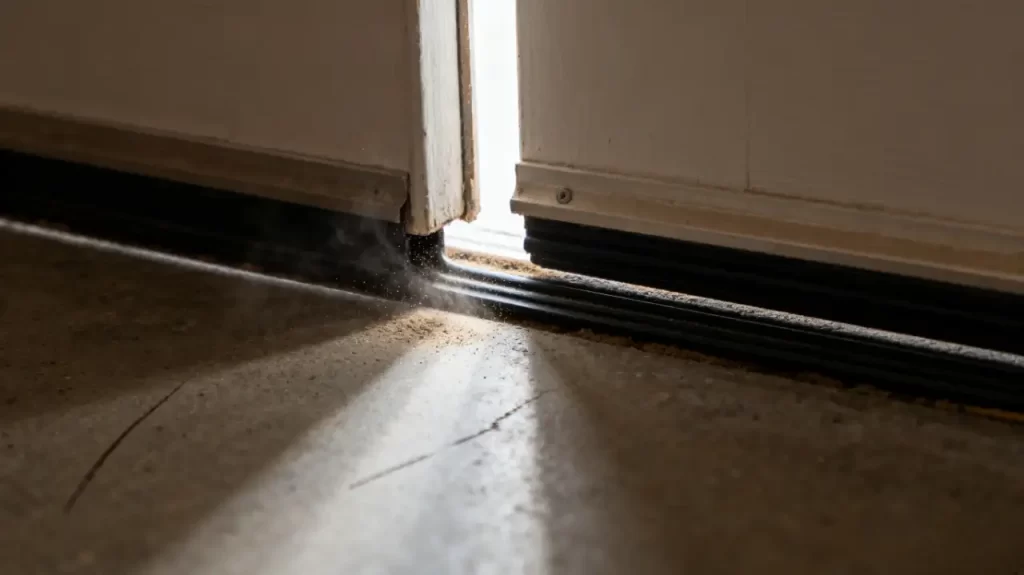
3.1 Common Leakage Locations and Mechanisms
Leakage in low-cost doors typically manifests at four critical interfaces:
- Header gap: Insufficient header rigidity allows mid-span deflection under door weight.
- Vertical side gaps: Hinge-side deformation under load; latch-side insufficient closing force.
- Threshold gap: Uneven flooring or absence of auto-drop seals permits pressure-induced separation — frequently observed in doors lacking engineered bottom brush seals.
- Gasket splice joints: Poorly executed splices open under thermal cycling.
Underlying causes:
- Coefficient of thermal expansion mismatch: Aluminum frames and low-grade EPDM seals respond differently to thermal and humidity cycles, inducing interfacial shear stress and progressive seal delamination. Repeated thermal cycling accelerates material degradation.
- Single-seal architecture: Absence of secondary compression or inflatable compensation mechanisms eliminates redundancy. Primary seal failure equates to total loss of airtightness.
- Lack of pressure-adaptive design: Under standard positive pressure regimes (often exceeding 50 Pa), doors without magnetic or mechanical latching systems are physically displaced, resulting in sustained pressure loss.
3.2 Quantified Impact: Leakage as a Contamination Vector
Per EN 16533:2019 (Cleanroom Door Airtightness Testing), under 50 Pa differential pressure:
- 0.3 mm gap: Approaches compliance limit.
- 0.5 mm gap: Exceeds allowable leakage rate.
- 1.0 mm gap: Functionally equivalent to an unsealed opening.
Microbial penetration risk is equally significant. Experimental data demonstrates that under 0.5 mm gaps with lateral airflow, micron-scale particle penetration exceeds 30%, and viable microbial aerosol transmission reaches double-digit percentages. The door ceases to function as a credible microbial barrier.
3.3 Regulatory Imperative: Zero Tolerance for Leakage
- GMP Annex 1 (2022): “All doors within classified areas shall maintain design pressure differentials in the closed position and prevent ingress of unfiltered air.”
- FDA 21 CFR 211.42(c)(10): “Access points to controlled environments shall be designed to close automatically and maintain seal integrity when unattended.”
In sterile manufacturing, door leakage constitutes a direct process failure risk and remains among the most frequently cited audit observations. Whether an airlock door, interlocked door, or panic-bar equipped door, loss of seal integrity nullifies its regulatory function. For airlock doors, dual-seal systems with pressure-synchronized interlocking are mandatory to ensure isolation integrity during personnel transit.
4. Failure Mode #3: Seized Hinges — Material Degradation and Mechanical Design Deficiency
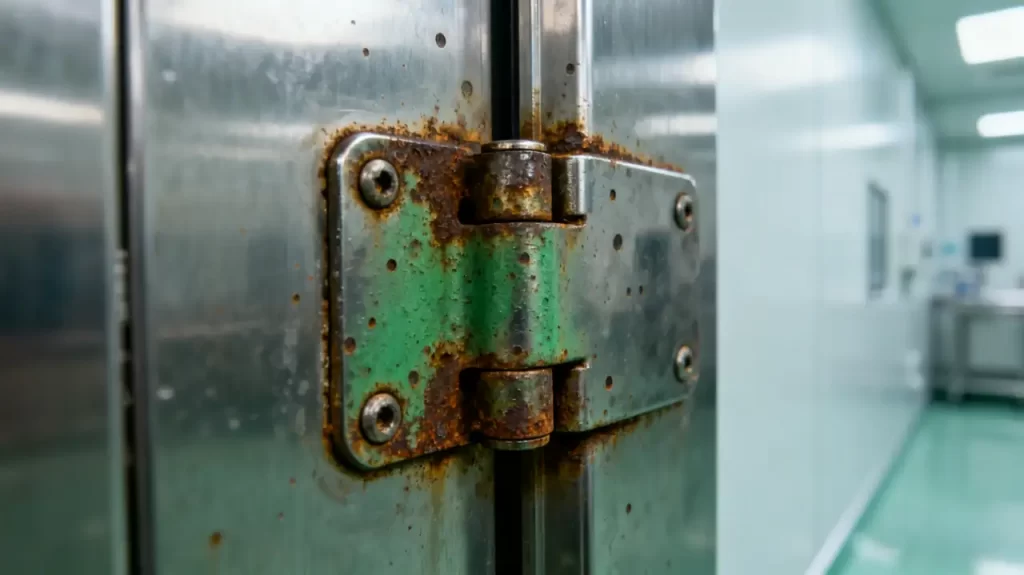
4.1 Symptoms and Root Causes
Hinge binding in low-cost doors is not a maintenance oversight — it is a consequence of systemic design compromise:
- Material corrosion: Use of low-grade stainless steel (or chrome-plated carbon steel) results in rapid oxidation under routine chemical disinfection protocols.
- Unsealed bearing assemblies: Ingress of fibers, particulates, and disinfectant residues into bearing races increases rotational resistance, culminating in seizure.
- Inadequate load rating: Hinges rated below actual door mass induce premature wear, resulting in door sag and threshold gap formation — directly compromising pressure differential integrity.
4.2 Operational and Compliance Consequences
- Contaminant introduction: Attempts to alleviate binding through application of industrial lubricants introduce hydrocarbons and VOCs into the controlled environment.
- Procedural noncompliance: High operating torque encourages partial closure or forceful engagement, resulting in chronic pressure loss and environmental excursions.
- Regulatory exposure: Recent FDA inspection observations for Chinese manufacturing sites repeatedly cite: “Failure of cleanroom doors to achieve full closure due to hinge malfunction constitutes an unmitigated microbial contamination risk.” This has become a recurring audit observation.
4.3 Standards Compliance: Hinges as Safety-Critical Components
- ISO 14644-4:2022, Annex B: Hinge assemblies shall demonstrate no functional degradation after 100,000 operational cycles.
- GB/T 38597-2020 (Cleanroom Doors Standard): Hinges shall be fabricated from austenitic stainless steel, with load capacity not less than 1.5 times the door mass.
Seized hinges reflect material substitution and structural under-engineering. The consequence is failure of the final engineered barrier — loss of function as an airtight assembly and microbial containment system. For masonry-mounted doors or heavy stainless steel cleanroom doors, hinge specification must account for thermal compatibility with sealing systems to prevent structural gaps induced by differential expansion.
5. Lifecycle Cost Analysis — Empirical Data from Operational Facilities
Initial procurement cost represents only a fraction of total ownership expense. Analysis of maintenance records from multiple pharmaceutical and medical device facilities reveals the following comparative performance:
| COST FACTOR | ECONOMICAL DOOR | ENGINEERED DOOR |
|---|---|---|
| Service life | < 18 months | > 5 years |
| Annual gasket replacements | > 2 | ≤ 1 |
| Hinge repairs/replacements | ≥ 1 per year | Minimal over 5 years |
| Cleanliness excursions | Recurrent | Rare |
| Audit observations | > 70% occurrence | < 10% occurrence |
| Mean repair duration | Several hours | < 30 minutes |
Five-Year Total Cost of Ownership Projection:
- Economical door: Low initial outlay is offset by frequent component replacement, unplanned downtime, and contamination-related losses — total cost often exceeds 10x purchase price.
- Engineered door: Higher capital investment is recovered through operational stability, minimal maintenance, and absence of batch loss — five-year TCO is consistently lower.
Conclusion: Lifecycle analysis demonstrates that low-cost doors frequently incur multiple times the total cost of engineered alternatives.
In pharmaceutical manufacturing, an underperforming pharmaceutical cleanroom door introduces systemic compliance risk — this is not a procurement decision, but a regulatory and reputational imperative. Supplier evaluation must include review of door specification sheets (profile thickness, seal compression force, torque characteristics), gasket aging test data, and integration capability with interlock control systems.
6. Engineering Mitigation Strategies — Designing for Long-Term Performance
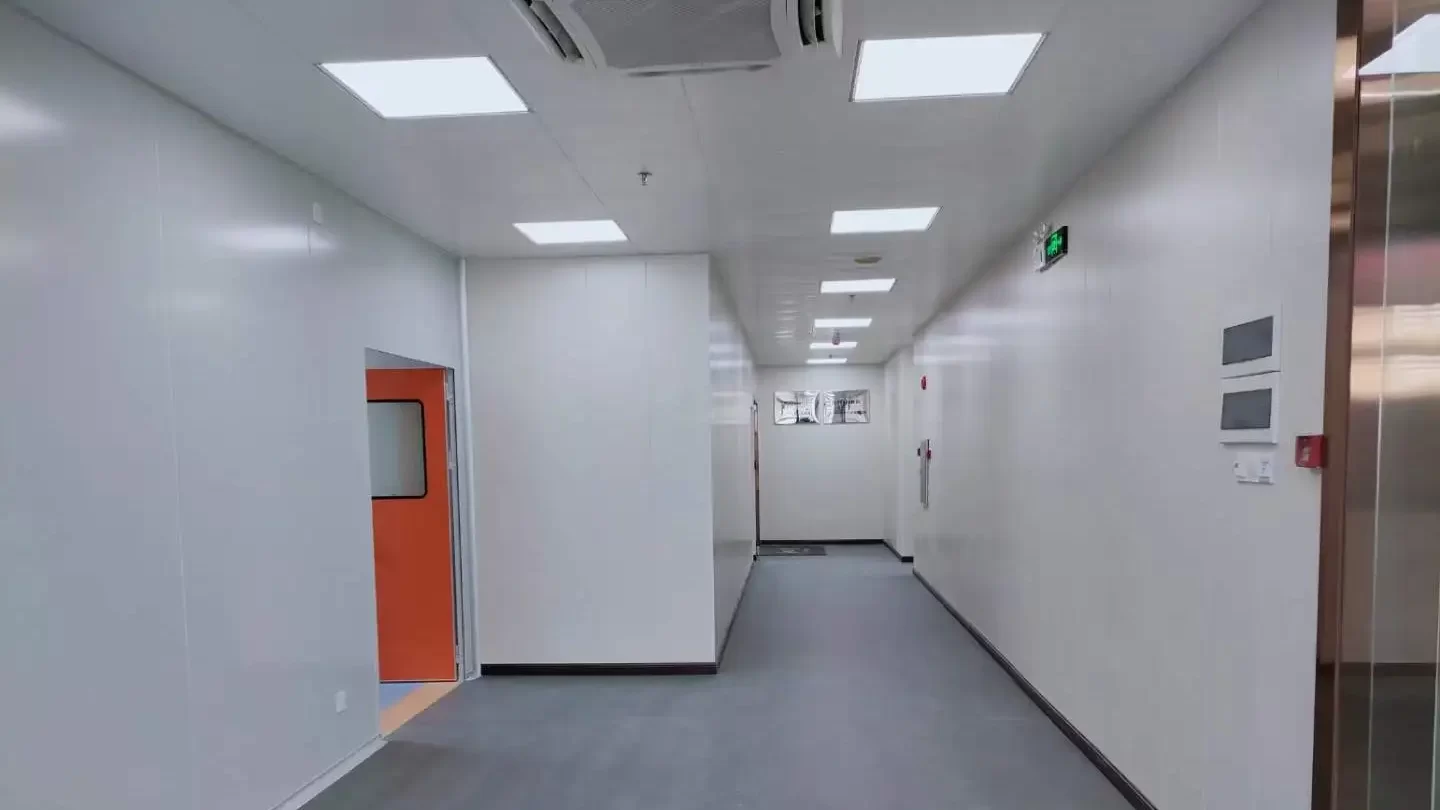
6.1 Material Specifications
- Frame: High-strength aluminum alloy (e.g., 6063-T5 or 6061-T6), minimum 1.5 mm wall thickness, with internal ribbing for enhanced rigidity and resistance to thermal deformation.
- Seals: Liquid silicone rubber (LSR), compression set ≤10%, resistant to frequent chemical exposure — avoid low-performance brush-type bottom seals.
- Hinges: Forged austenitic stainless steel, fully sealed bearings, rated for 1.5x door mass, validated for 100,000+ cycles — engineered to resist resonance-induced degradation.
6.2 Structural Design Principles
- Dual-seal architecture: Primary compression gasket with secondary mechanical or magnetic assist — ensures containment integrity upon primary seal degradation.
- Compensating frame design: Integrated elastic elements along all four perimeter edges accommodate installation tolerances and thermal expansion, preserving seal continuity.
- Auto-drop threshold seal: Deploys upon closure to conform to floor irregularities — superior to static brush seals, particularly for swing door applications.
- Reinforced hinge mounting: Embedded steel reinforcement plates prevent fastener pull-through and maintain alignment under load — critical for pressure differential stability.
Application-specific considerations:
- Airlock doors: Require differential pressure sensors and fail-safe interlocking to ensure dual-door sealing during transit.
- Stainless steel doors: Suitable for corrosive environments — must be paired with thermally compatible sealing systems.
- Sliding doors: Fully enclosed track systems with load-rated rollers and redundancy.
6.3 Validation and Performance Testing
- Airtightness verification: 100% factory testing under 50 Pa differential pressure, leakage rates compliant with ISO 14644 — validates microbial barrier efficacy.
- Cycle endurance: Minimum 100,000 operational cycles with <10% degradation in sealing force or hinge torque — validates resistance to material fatigue.
- Environmental conditioning: Exposure to repeated thermal/humidity cycles without seal cracking, delamination, or frame distortion — validates performance under thermal stress.
For dynamic door systems:
- High-speed doors: Validate closure velocity (≤0.8 m/s) to minimize pressure transient impact.
- Roll-up doors: Test seam integrity under operational cycling to prevent particulate ingress.
- All systems shall be accompanied by comprehensive cleanroom door specification documentation for engineering review and commissioning.
7. Conclusion: Cleanroom Doors as Engineered Systems — Not Commodity Items
Cleanroom door performance is governed by the convergence of materials science, mechanical engineering, fluid dynamics, and environmental control theory. Its value is not reflected in the purchase order — but in its capacity to sustain target cleanliness classifications, pressure regimes, and airflow patterns continuously over its service life.
Selection of low-cost doors represents a classic case of cost myopia — marginal savings at procurement translate into significant operational, compliance, and reputational exposure. In pharmaceutical environments, these assemblies must be recognized as pharmaceutical cleanroom doors — physical embodiments of GMP, and the final engineered microbial barrier.
Critical evaluation criteria include:
- Availability of third-party airtightness certification.
- Verifiable frame thickness and internal reinforcement.
- Specification of hinge material grade and load rating.
- Presence of redundant sealing architecture.
- Integration of thermal expansion compensation and vibration damping features.
- Compatibility with interlock controls and automated door operators.
In controlled environments, there is no such concept as “adequate.” There are only systems that perform — and systems awaiting failure.
Do not permit a single component to compromise an entire contamination control strategy. And under no circumstances should it become the subject of your next regulatory audit observation.
-
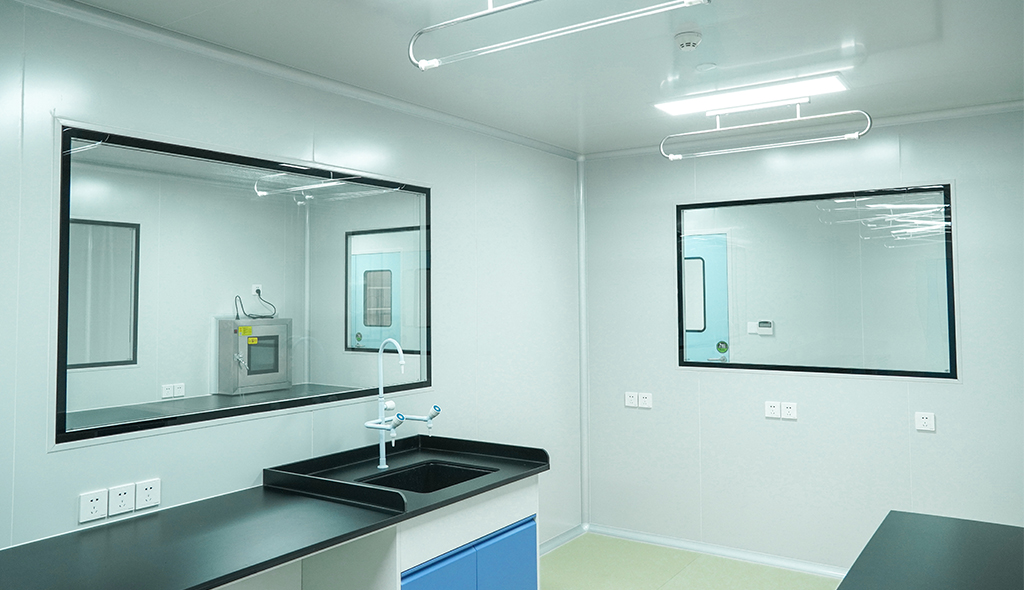 Cleanroom Glass Windows Are The Key to Maintaining a Clean Environment
Cleanroom Glass Windows Are The Key to Maintaining a Clean Environment -
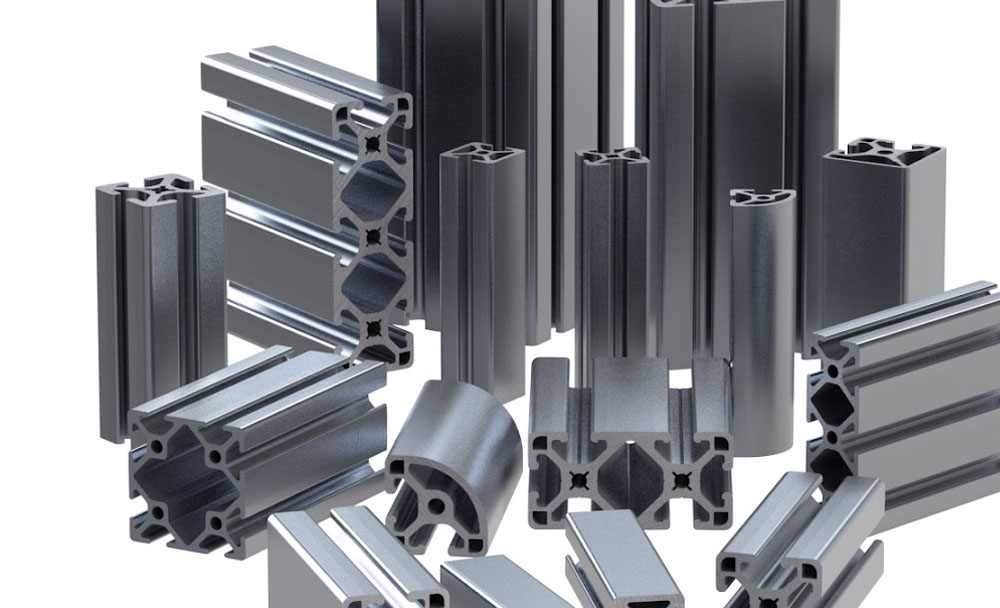 Top Aluminium Profile Manufacturers in China: Leading the Global Market
Top Aluminium Profile Manufacturers in China: Leading the Global Market -
 The Evolution of Air Tight Sliding Doors
The Evolution of Air Tight Sliding Doors -
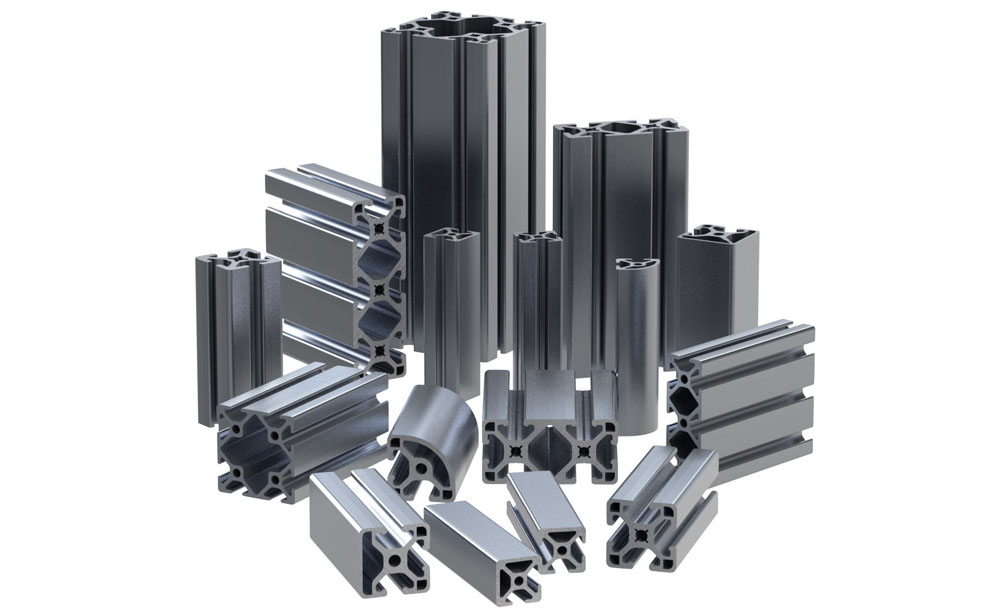 AHU Aluminium Profile: A Comprehensive Guide
AHU Aluminium Profile: A Comprehensive Guide -
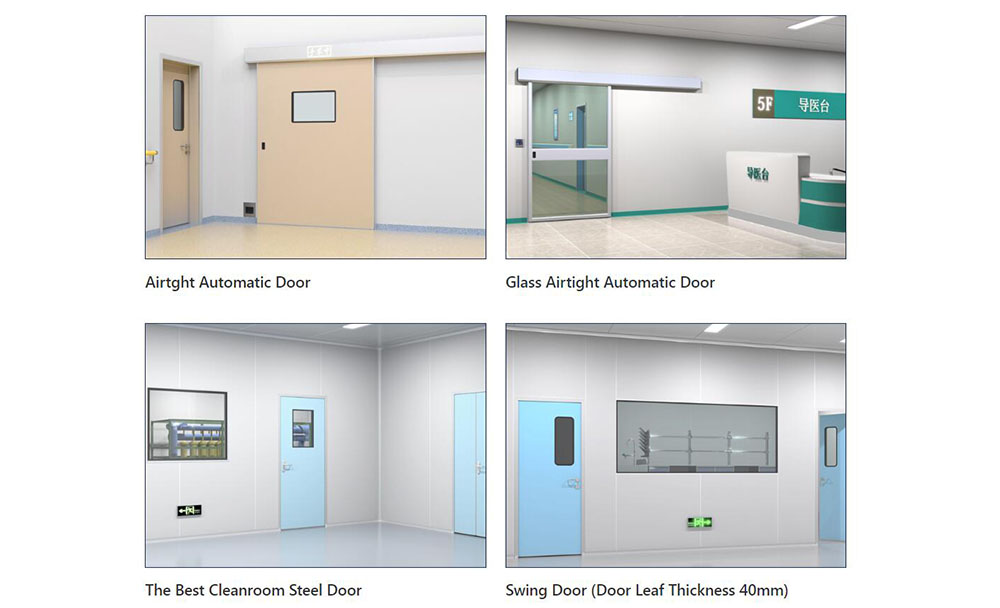 The Importance of Choosing the Right Cleanroom Door in Vietnam
The Importance of Choosing the Right Cleanroom Door in Vietnam -
 The Benefits of Hospital Automatic Doors: Enhancing Efficiency and Safety
The Benefits of Hospital Automatic Doors: Enhancing Efficiency and Safety -
.jpg) The Best Bathroom Door Manufacturers - Unlocking Endless Possibilities!
The Best Bathroom Door Manufacturers - Unlocking Endless Possibilities! -
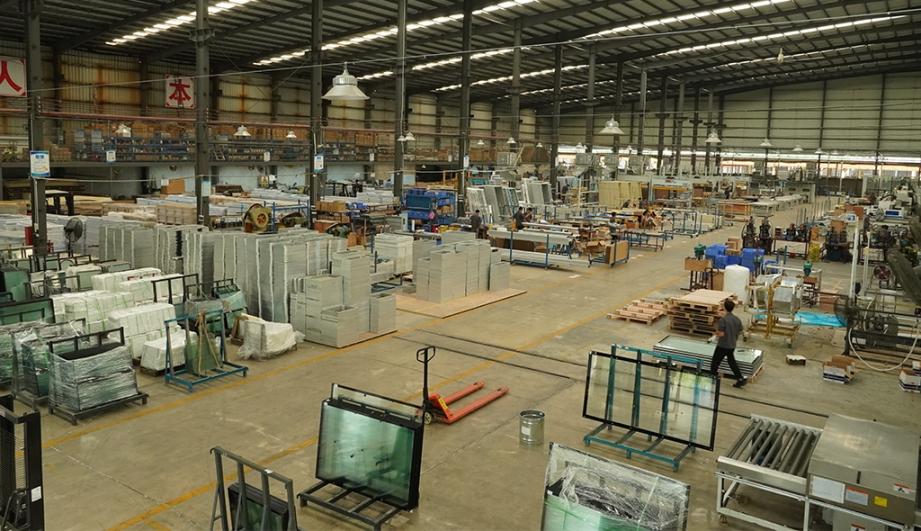 Unlock the Possibilities with AJ Manufacturing Doors
Unlock the Possibilities with AJ Manufacturing Doors -
 Make a Statement with Manufactured Home Interior Doors!
Make a Statement with Manufactured Home Interior Doors! -
 what is aluminum profile? Aluminum Profiles for Your Home is the best option
what is aluminum profile? Aluminum Profiles for Your Home is the best option
-
 How to Extend the Life of Your Exterior Steel Door
How to Extend the Life of Your Exterior Steel Door -
 What Are the Best Materials for AC Vent Covers
What Are the Best Materials for AC Vent Covers -
 Ceiling Vent Covers Labeled Fire-Rated? Here’s How to Verify
Ceiling Vent Covers Labeled Fire-Rated? Here’s How to Verify -
 Upgrading Lab Doors: When to Replace vs. When to Retrofit?
Upgrading Lab Doors: When to Replace vs. When to Retrofit? -
 Stainless Steel Door vs. Alternatives in Cleanrooms
Stainless Steel Door vs. Alternatives in Cleanrooms -
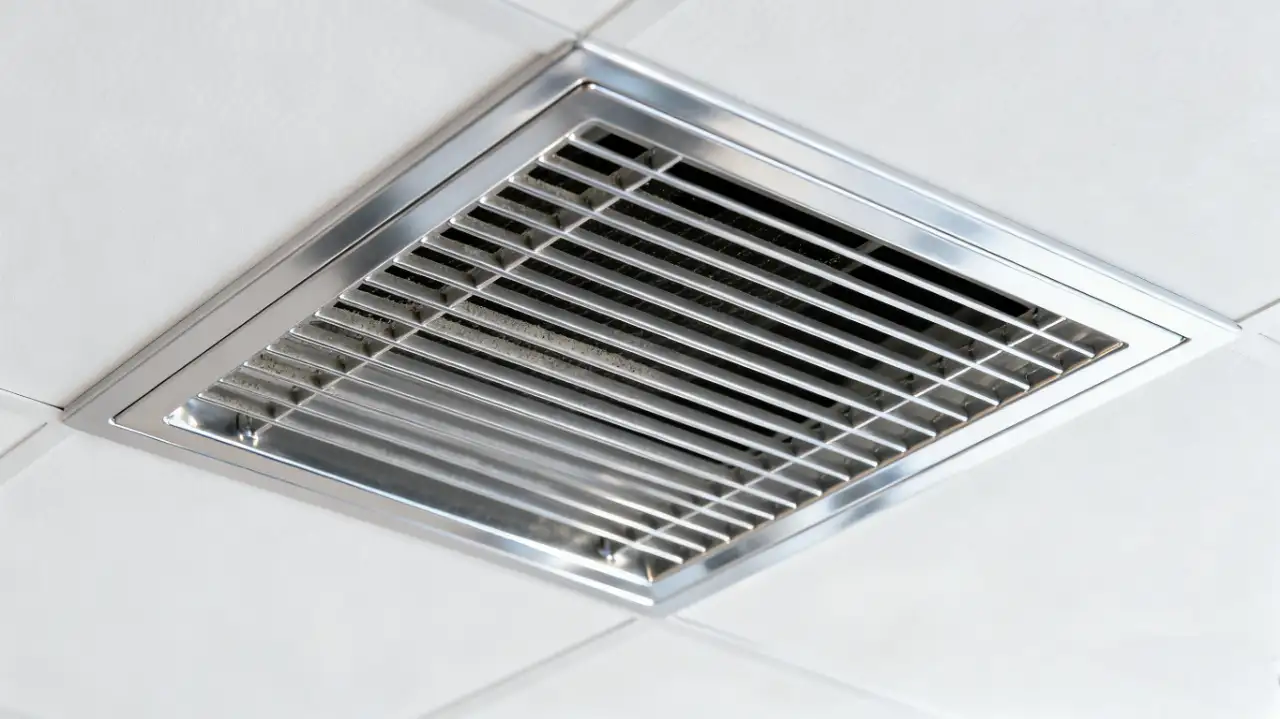 Ceiling Vent Care Tips to Boost HVAC Efficiency Year Round
Ceiling Vent Care Tips to Boost HVAC Efficiency Year Round -
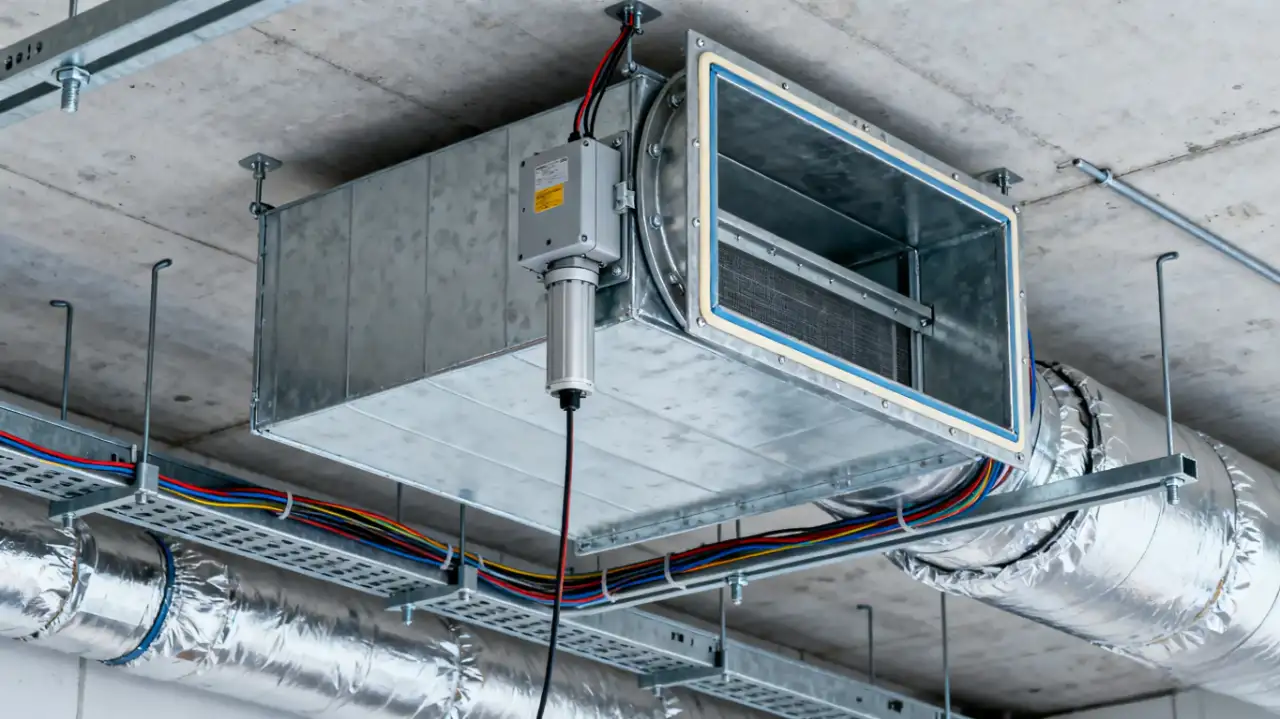 How Air Dampers Drive Efficiency in High Performance Buildings
How Air Dampers Drive Efficiency in High Performance Buildings -
 Why Semiconductor Manufacturing Can’t Function Without Cleanrooms
Why Semiconductor Manufacturing Can’t Function Without Cleanrooms -
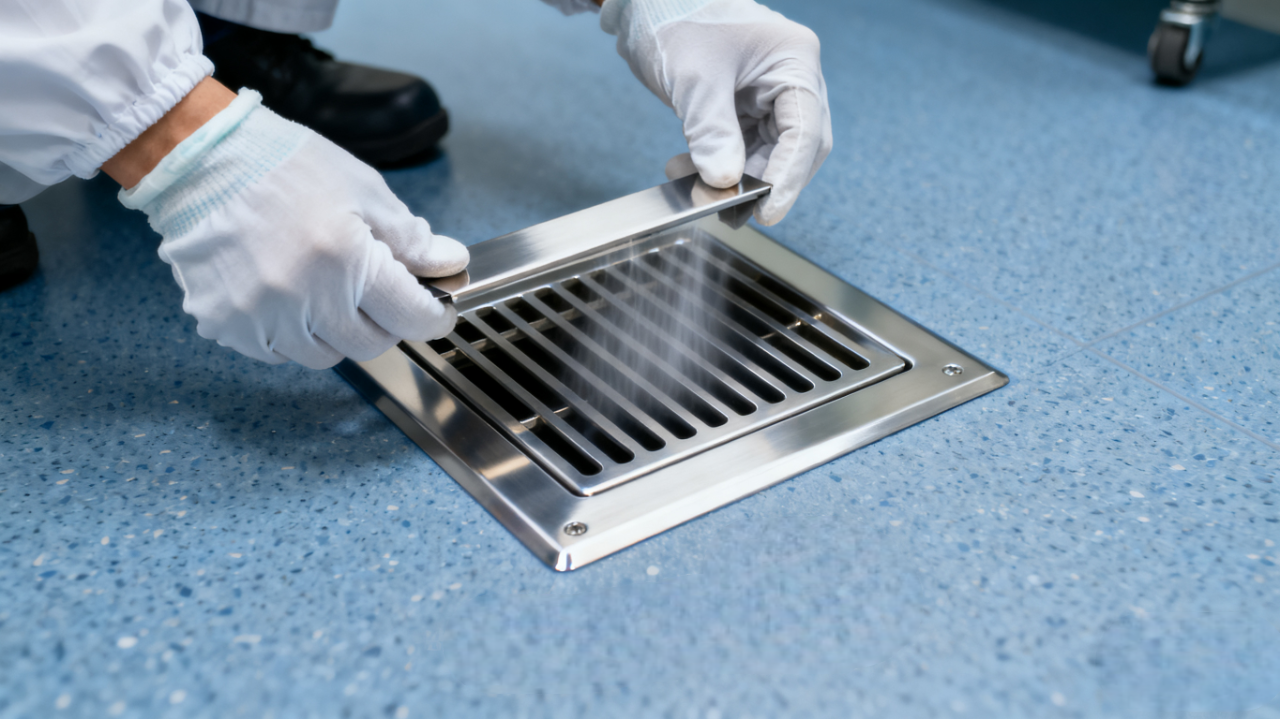 How to Select the Right Floor Vent for Cleanrooms
How to Select the Right Floor Vent for Cleanrooms -
 How to Clean and Maintain AC Registers for Peak HVAC Performance
How to Clean and Maintain AC Registers for Peak HVAC Performance

Guangzhou Yizhong Aluminum Industry Co., Ltd.
We are always providing our customers with reliable products and considerate services.
We are always providing our customers with reliable products and considerate services.


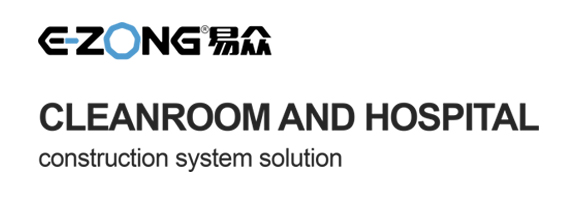
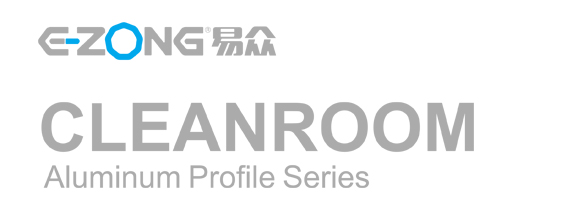
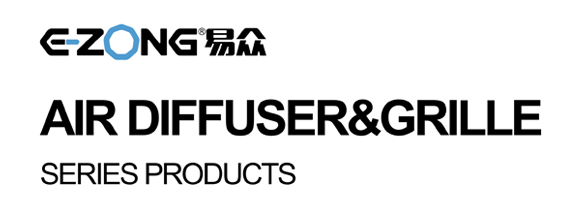





Speak Your Mind